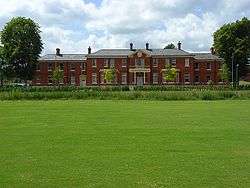Tidworth Camp
| Tidworth Camp | |
|---|---|
| Tidworth | |
 Lucknow Barracks | |
 Tidworth Camp Location within Wiltshire | |
| Coordinates | 51°13′56″N 1°40′28″W / 51.23217°N 1.67451°WCoordinates: 51°13′56″N 1°40′28″W / 51.23217°N 1.67451°W |
| Type | Barracks |
| Site information | |
| Owner | Ministry of Defence |
| Operator |
|
| Site history | |
| Built | 1897 |
| Built for | War Office |
| In use | 1897–present |
| Garrison information | |
| Occupants |
1st Armoured Infantry Brigade 1st Artillery Brigade and Headquarters South West |
Tidworth Camp is a military installation at Tidworth in Wiltshire.
History
The Camp was established when the War Office acquired Tedworth House and large tracts of land to the north of the house in 1897.[1] Southern Command was established at Tidworth Camp in 1905.[2]
Lucknow Barracks and Mooltan Barracks were completed in 1905, Tidworth Military Hospital was finished in 1907. Aliwal Barracks, Assaye Barracks, Bhurtpore Barracks, Candahar Barracks, Delhi Barracks and Jellalabad Barracks were added later.[3] A Royal Ordnance depot was established during the First World War.[1] The names of the barracks evoke memories of battles in India and Afghanistan (e.g. Aliwal, Assaye, Bhurtpore, Candahar, Delhi, Jellalabad, Lucknow and Mooltan).[4]
In the Second World War, the Camp was home in 1944 to formations of the United States Army: first the 9th Armored Division,[5] and later the 8th Armored Division.[6]
A branch from the Midland and South Western Junction Railway at Ludgershall was built in 1901 and opened to passengers in 1902.[7][8] Goods tracks known as Tidworth Military Railway continued from Tidworth station into the military area. The branch returned to military control in 1955 and was closed in 1963.[1]
Tidworth Military Cemetery was set up to serve the barracks. It includes the war graves of 417 Commonwealth service personnel of the First World War and 106 of the Second World War.[9]
Southern Command left the Camp and moved to Erskine Barracks near Fugglestone St Peter in 1949.[10] The Military Hospital closed in March 1977.[11]
Extensive reconstruction at the Camp involving 160 new or refurbished buildings was carried out under Project Allenby Connaught between 2006 and 2014.[3]
Current occupants
Delhi Barracks is home to Headquarters 1st Armoured Infantry Brigade and its affiliated units[12] and Jellalabad Barracks is home to Headquarters 1st Artillery Brigade and Headquarters South West and its affiliated units.[13]
References
- 1 2 3 "Tidworth Concise History". Wiltshire County Council. Retrieved 22 November 2014.
- ↑ "General Sir Ian Hamilton". Liddell Hart Centre for Military Archives. Retrieved 22 November 2014.
- 1 2 "Tidworth Overview". Aspire Defence. Retrieved 22 November 2014.
- ↑ "Mooltan Barracks, Tidworth". British listed buildings. Retrieved 6 March 2017.
- ↑ Ken Wakefield (24 March 2014). The Other Ninth Air Force: Ninth US Army Light Aircraft Operations in Europe 1944-45. Fonthill Media. GGKEY:6KCZWNPHUL0.
- ↑ Charles R. Leach (1992). In tornado's wake: a history of the 8th Armored Division. Battery Press. p. 47.
- ↑ Historic England. "Tidworth Military Railway (1359011)". PastScape. Retrieved 1 March 2015.
- ↑ Crawford, T.S. (1 August 2012). Wiltshire and the Great War. Crowood. ISBN 978 1 84797 447 1.
- ↑ "Tidworth Military Cemetery". Commonwealth War Graves Commission. Retrieved 2 December 2014.
- ↑ "'Fugglestone St Peter', in A History of the County of Wiltshire: Volume 6". 1962. pp. 37–50. Retrieved 22 November 2014.
- ↑ "Tidworth Military Hospital". Retrieved 22 November 2014.
- ↑ "1 Armoured Infantry Brigade". Ministry of Defence. Retrieved 22 November 2014.
- ↑ "Historic event takes place in Tidworth Camp". British Army. 10 December 2014. Archived from the original on 23 September 2015. Retrieved 13 August 2015.